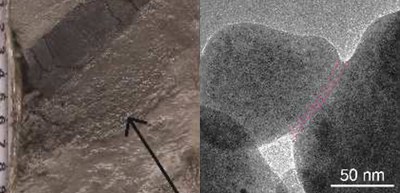
Black disk-shaped fault rock caused by sintering affects the post-seismic fault healing
A group of researchers from Osaka University, the Research Center for Thermal and Entropic Science, the Kochi Institute for Core Sample Research of the Japan Agency for Marine-Earth Science and Technology (JAMSTEC), and Hokkaido University has revealed that a kind of natural ceramics generated by sintering in faults during an earthquake affected earthquake energetics and post-seismic fault healing. (Fault healing is recovery of pre-failure fault strength between earthquakes.)
Sintering, the process in which loose particles fuse into a coherent body at a temperature below the melting point of the particles, is part of the firing process used in the manufacture of pottery, porcelain, and other ceramic objects. Since it was originally assumed that earthquakes generated frictional melting and wall rock damage, the sintering process in a fault during an earthquake was not studied.
This research group participated in the Taiwan Chelungpu-fault Drilling Project under the auspices of the International Continental Scientific Drilling Program (ICDP)) in 2003 and collected borehole rock samples of the Chelungpu fault, which slipped during the 1999 Chi-Chi earthquake.
Initially, a disk-shaped black fault rock at a depth of 1194 m found in one of the Chelungpu-fault zones was interpreted to result from frictional melting. In this study, the researchers examined samples from the Chelungpu Fault on a nano-scale and found that a bonding process between solid particles in contact under high temperatures caused them not to melt, but rather, to consolidate by sintering powder particles. That is, a kind of ceramic was generated in the fault via sintering during an earthquake.
They heated mineral aggregates (quartz, feldspar, and clay mineral) in experiments and found that only those mixtures that included chlorite showed exothermic peaks and bonding structures (neck growths). Chlorite functioned as an auxiliary sintering agent. (A neck is formed at the contact points between particles in the initial stage of sintering.)
Since ceramics show much higher strength than those made of particles, when a rock in the fault turns into ceramics, the fault strength is enhanced. In addition, since sintering reduces surface area by growing bonds between contacting particles, surface energy is released, that is, heat is generated. This surface fracture energy is added to energy released from a fault during an earthquake and significantly affects various chemical reactions in the fault after an earthquake, such as recrystallization of minerals.
This group suggested the possibility that sintering just after the earthquake facilitated recovery of pre-failure fault strength. The discovery of the structural traces of neck growth between nanoparticles in the fault is an essential finding required for estimating the earthquake recurrence interval.
This group’s achievements will greatly develop fault analysis in active fault research and fault drilling projects, and will clarify the healing process of fault strength. This will also enhance the accuracy of activity evaluation of plate boundary faults and active faults.
Figure 1
Figure 2
The article, "Generation of sintered fault rock and its implications for earthquake energetics and fault healing," was published in Communications Earth & Environment at DOI: DOI: 10.1038/s43247-020-0004-z.
